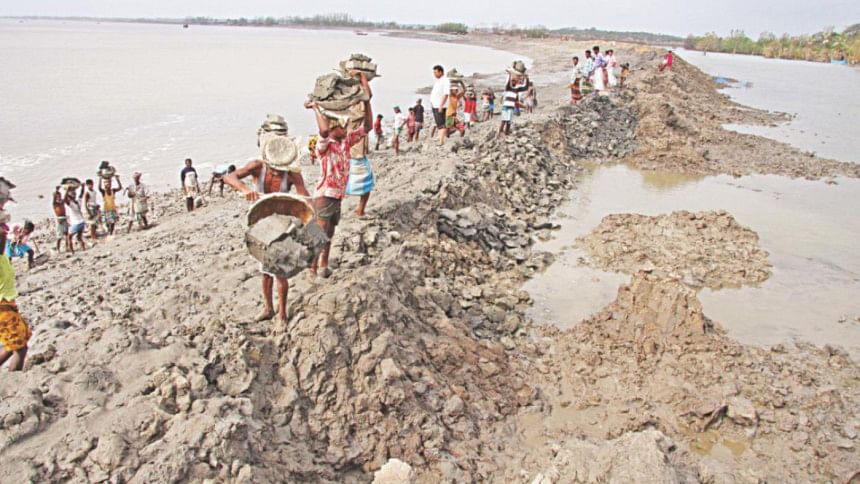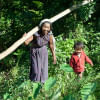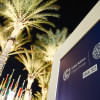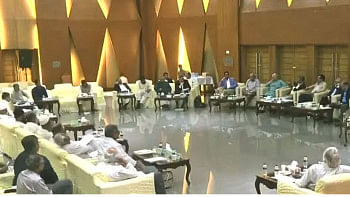Climate finance in Bangladesh

Over the last decade in Bangladesh, we have spent almost a billion US dollars on several hundred projects and activities to tackle climate change. Most of these projects have been on adaptation but a few have also been on mitigation.
As tackling climate change is a new issue for us, there is no pre-existing methodology to follow, and hence, mistakes were bound to happen. As we move forward to investing more money in future, it is important to first acknowledge our mistakes and then learn from them so that we do not repeat them.
Making mistakes is not a waste of money unless we fail to learn from the mistakes; not learning from mistakes and then repeating them is the real waste of money.
Hence, in the spirit of acknowledging mistakes and trying to learn from them, I will analyse our experiences in the realm of allocating finances to tackle climate change (I will discuss the associated issue of utilisation of funds in a separate article later).
I should start by saying that my impressions are based not on inside knowledge of any of the funding mechanisms I will review, but what is publicly available. Some data may not be accurate but I hope the analysis is still valid.
I will review the allocations of finances through the Bangladesh Climate Change Trust Fund, the Bangladesh Climate Resilience Fund, the Palli Karma Shahayak Foundation and the Pilot Project on Climate Resilience, as well as talk about the Green Climate Fund, which will be the new global fund for tackling climate change.
Bangladesh Climate Change Trust Fund (BCCTF)
The setting up of this fund under an Act of Parliament and the Government of Bangladesh funding it from its own resources over a number of years was a groundbreaking and laudable initiative.
It also set up good systems (at least on paper) of reviewing proposals and allocating resources to projects. Over the last six years or so, it has disbursed several hundred million US dollars to several hundred projects in different ministries of the government as well as to NGOs.
However, unfortunately over time, a number of instances of misallocation were brought to light by journalists and NGOs such as Transparency International Bangladesh (TIB).
From the point of view of the government, it is not important whether the exact facts in the reports were accurate or not, rather the focus should be on the fact that the overall impression of this project fund was quite negative; it should be remembered that once reputation is lost, it becomes very hard to regain it.
Bangladesh Climate Resilience Fund (BCRF)
This fund was set up alongside the BCCTF but with international funds from development partners such as the United Kingdom, the European Commission, Denmark and others. It had a different governance structure with the donors represented in its governing board and was also managed by the World Bank rather than the government.
It also allocated funds to somewhat larger projects than the BCCTF and had a more robust evaluation system. It managed a few hundred millions of US dollars that were being allocated to fewer (but bigger) projects than the BCCTF. However, it was quite slow in disbursing funds and it is now being wound up with money left unspent, according to newspaper reports.
Palli Karma Shahayak Foundation (PKSF)
Both the BCRF as well as the BCCTF had made a decision to pre-allocate 10 percent of their total funding to the civil society to support grassroots and community level adaptation to climate change. PKSF, on the other hand, was chosen as the agency to manage those funds.
At the time, PKSF did not have any experience on climate change but had disbursed many hundreds of millions of US dollars to several NGOs for micro- credit and it had a very robust monitoring system.
PKSF set up a new climate change cell to handle the climate funds it received from both BCRF as well as BCCTF and has, over the years, funded many NGOs who are working at community level.
From a simple review of the information provided on allocation of funds at their respective websites, PKSF is by far the most transparent and, by all accounts, the best run of the various funds.
Pilot Project on Climate Resilience (PPCR)
This was a separate fund from the World Bank in Washington, as it was managed by the Asian Development Bank (ADB) in Bangladesh, and involved the International Finance Corporation (IFC) to bring in the private sector to tackle climate change. The task of involving private sector in mitigation is relatively easy but bringing them into adaptation is not. So it has not been easy to find private sector interest here.
Green Climate Fund (GCF)
This is the new fund set up under the United Nations Framework Convention on Climate Change (UNFCCC) to channel $100 billion a year from the developed countries to the developing countries to help tackle climate change. Bangladesh will have to compete with other countries in order to get funds from the GCF. Fortunately, Bangladesh was among the first eight countries to be allocated funding by the GCF.
Lessons learnt
First of all, the time for having standalone climate funds, such as the BCCTF and BCRF, are over, as the national planning and finance systems are fully geared up to mainstream climate finance with national development finance. The government has indeed already recognised this fact by designating the Economic Resources Division (ERD) to be the National Designated Authority (NDA) for the GCF.
Additionally, ministries across the government have now acquired enough knowledge of climate change to enable them to start mainstreaming it into their regular development plans.
Moreover, the need for Bangladesh to deliver on the Sustainable Development Goals (SDGs) over the next fifteen years allows climate change finance to be well integrated across the SDGs as well.
Finally and perhaps most importantly, we need to focus on the need to put in robust systems of transparency of climate fund allocations by governments and other donors, along with robust systems of oversight and accountability by both the sectors of government responsible for those functions, such as the Auditor General and Parliamentary Standing Committees, as well as by third party monitors, including the citizens themselves.
The $100 billion a year promised by the developed countries - to begin from the year 2020 - to the developing countries is a floor and will grow over time. Bangladesh, being one of the most vulnerable developing countries, has a good chance to get significant amounts from the GCF, but it will have to compete with other countries to get it. The criteria by which we will get more funding is not by asserting our vulnerability over others, but rather by demonstrating good practice in transparency and accountability of climate funding.
The writer is Director of the International Centre for Climate Change and Development at Independent University, Bangladesh.
Email: [email protected]

 For all latest news, follow The Daily Star's Google News channel.
For all latest news, follow The Daily Star's Google News channel. 








Comments